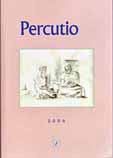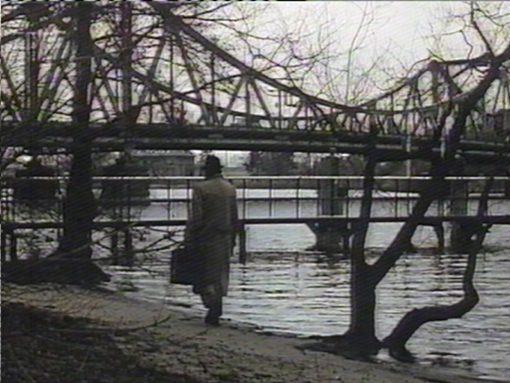Journal: Percutio
 Cover:
S. Bianciardi
Cover:
S. Bianciardi |
An
annual published in hard copy in New Zealand and France paying
special attention to the creative process and issues relating
to translation.

Cover:I.A.Goldsmith |
Percutio is dedicated
primarily to reflections upon the creative process, particularly
in relation to work that bridges cultures.
 Cover:
N. Bunn
Cover:
N. Bunn |
Percutio may, therefore,
feature poetry, essays, extracts from novels, choreography, approaches
to composition and journal entries in English and the language
of creation.

Cover:A.
Loeffler |
The deadline each year is April 10th.
Submissions are welcome.
View
the pilot issue (without images) free of charge here.
View the contents lists and editorials of past issues here.
Download past issues
Format: Adobe
Suitable devices: Tablet PCs, PCs, Macs, Laptops
|

OPEN
ACCESS ESSAYS
Bridging,
Living, Writing
An essay by German
scholar Nils Plath, translated
by the author. First published in Percutio
2006 (added 16.06.2010).
Bridging,
Living, Writing
Nils
Plath
for
C.P. in K.
'Reading
is like a translation from one riverbank
to another, from writing into language.
The work of a translator of a 'text'
is a translation from coast to coast,
from one mainland to another, from Text
to Text.'(1) We read this in an essay
by Hans-Georg Gadamer. A not-entirely-new
topos is presented here, as well as
a familiar figurative language, with
whose help the execution of understanding
in interpretation and interpretation'
s basic linguistic and literary concepts
are described. According to this hermeneutical
view, even the reading of poetic 'texts'
in their original language is equivalent
to translation. Reading resembles a
rerendering (translation) into a foreign
language. Two entities again, separated.
It is remarkable how many statements
about reading, understanding, and translation
are secured by metaphors of place.
The
bridge, a lofty symbol. The German language
contains the word 'Baukunstwerk': architectural
art-work. Many bridges belong to this
category, but, perhaps more so than
any other type of architecture, the
traditional definition of bridges subjugates
them to the domination of a primary
function: a bridge guarantees transportation.
Or so it appears. A sentence from a
documentary film tells a different story:
'The autobahn bridge registers a perspective
in the countryside.' The film's title:
Reichsautobahn. Direction, script,
editing: Hartmut Bitomsky, first screened
in 1986. The film is about the German
autobahn, built in the thirties, a man-made
myth, a perfect piece of art, whose
bridges came to have the effect that
cathedrals once had. From the voice-over:
'There were two factions among the bridge
builders that butted heads with each
other. Architects here, engineers there.
That's the way the roles were distributed.
One side wanted to construct modern
bridges out of concrete and steel. The
other side wanted bridges built out
of massive stone blocks and mortar.
'We love the heavy walls and narrow
arches of old bridges,' said one side.
'We demand a clear emphasis on function,
the clear presentation of the building
forces in every detail, clean lines,
avoidance of every unnecessary accessory,
no compromises, the simplest and clearest
form.' The others called this soulless
calculation. The task of their builder
was to form material and mass, not reproduce
it. To build [...] means to form the
space: the Autobahn will become sculpture
in the space surrounding it. Concrete
is an artificial material, it has no
patina, but stone bridges are as festive
as cathedral arches... [The outcome
was that] stone bridges as well as concrete
bridges [were] built for the Autobahn
[...] and, in fact, most of the stone
bridges had an internal concrete structure.
There was only an illusion of stone.
Whoever drives over a bridge won't notice
much about the aesthetic of the architecture
anyway. The bridges were meant to be
viewed from beyond the autobahn.'(2)
They were parts of a network of roads
conceived as a work of art, it was said.
And more: 'The autobahn cut into the
country. It created a context.'(3)
To
divide and connect, part of one operation.
To manufacture connections that can
then be observed by others. And perhaps
only by others. For as we know from
reading Elfriede Jelinek' s Wolken.Heim
not everyone observes while driving.
They are in an emphatic mood: 'A good
feeling, to drive through the night
over our autobahn bridges. Underneath
them, lights shine out from the pubs:
even more people like us! A bright light.
The characters, strangers as we are,
travellers stream into the bus stations,
distributing themselves from place to
places...'(4) We are we. (The ultimate
tautology.) We, who attest to ourselves.
We, who are here Belong to us. Are among
us. At home. At least soon.
In the conventional view, such as that
of Gadamer, translators are proper bridge
builders who, conversely, take care
that there is 'constantly flowing traffic.'
(And if the traffic is blocked, clogging
up, one feels disappointed.) They guarantee
an undisturbed mediation between the
self and its reading material. Translations,
although also of practical necessity,
according to the conventional definition,
rank behind the original they are of
secondary importance. The authority
of the original text, especially of
the literary self of irreducible distinctiveness,
remains, in contrast to the translation,
beyond question. This authority is perpetuated
by the effects of the translation: the
authority of the original is handed
down. At the same time, the act of force
that comes from its definitive purpose
is veiled while a type of literary criticism
develops, demanding to be recognized
as law, which refers to this authority.
What
if we, while a border is being crossed
even after such a strategically planned
operation as construction of a bridge
or bridgehead encounter ghosts? Ghosts
that cause a loss of figurativeness,
ghosts that haunt the translation of
words into another language without
serving understanding, without allowing
us complaisant rest in peace and unity.
'I had hardly crossed the border when
ghosts came toward me,' reads an intertitle
from Friedrich Murnau' s Nosferatu
(1922) that reappears in Jean-Luc
Godard's film Allemagne Neuf Zéro
(1990). A portrait of a country
undergoing unification, becoming something,
a state in a state of emergency, unshaped
and undefined, depicted by a filmmaker
who frankly admits using the past to
portray the future: 'In the whole film
there is almost no word of my own: it's
all quotations, but they have all passed
through my memory.' A sentence to illuminate
an idea. To speak, that is, to quote,
with the words and images of others,
foreign ones? Traces of memory to describe
a time yet-to-come (avenir). Can one
ever do anything else here and now?
After this intertitle, Eddie Constantin,
playing the re-awakened secret agent
Lemmy Caution from Alphaville (1965),
ferries himself across the river right
beside the Glienicker Brücke in
Berlin, a bridge whose eastern part
was in the west: more exactly, in the
American Sector of Berlin. The bridge
poses a special challenge to the perspective,
since over it, in daily life, ran an
impassable border. 'We had to protect
the bridge from attack from our own
hinterlands and West Berlin,' one former
commanding officer recalls: 'The border
guards here, as throughout the entire
border system, kept an eight-hour watch.
There was a border patrol around the
clock. This patrol did not stand directly
on the bridge, since it was completely
obstructed for reasons of security.
At the end of the bridge, there were
enormous concrete blocks; they were
planted with flowers...'(5) The bridge
served as the stage for public- pleasing
gestures of détente: the exchange
of agents, who in the words of the Berlin
GDR news agency ADN were called 'scouts'
(Kundschafter). They got into large
limousines with shaded windows, observed
by television cameras and journalist's
cameras; that is, by apparatuses used
by the media to spread images meant
to illustrate an otherwise invisible
cold war and a block building determining
the thoughts and lives. The bridge,
a true-to-style staging of reality that
used a form of fiction the spy film
as its model, became, in turn, the model
for yet other future spy films. A bridge,
made to be observed from both sides
had become an observation platform of
use to both sides.
'The
bridge connects', says Heidegger in
'Bauen Wohnen Denken' , 'not only pre-existing
banks. The banks first appear as such
when crossing the bridge. It is the
bridge that places them on opposite
sides through the bridge, one side is
distinguished from the other. The banks
do not run along the sides of the stream
like insignificant outlines of the solid
land. The bridge brings not only the
two shores together but, one way or
another, it brings the hinterland behind
the shores to the current. The bridge
brings river, bank, and land together
in multi-layered reciprocal proximity.'(6)
Without the bridge, banks and land were
unthinkable or, at least, unrecognizable
as different entities. If we are reluctant
to cross evident abyss between text
and text, culture and culture, translation
and translation, might we not, with
the help of translations, perceive and
apprehend this difference and try to
examine the jostling for position and
the obsessions that are closely linked
to the very act of translating? An obsession
with voids, for instance, or one that
turns difference into a stabilizing
force capable of forging (forming) identity.
The task is also a question: how may
this 'economy' of reading that circulates
throughout and through every translation
be described? This can be called the
task of the translator.

Jean-Luc
Godard: Allemagne Neuf Zéro
1.
Hans-Georg
Gadamer,
'Lesen
ist
wie
UEbersetzen'
, in:
Gesammelte
Werke,
Band
8, AEsthetik
und
Poetik
1. Kunst
als
Aussage,
Tuebingen
1993,
p. 284.
2.
Hartmut
Bitomsky,
'Reichsautobahn'
in:
Jutta
Pirschtat
(ed.).
Die
Wirklichkeit
der
Bilder.
Der
Filmemacher
Hartmut
Bitomsky,
Essen
1992,
p. 75.
3.
ibid
p. 76.
4.
Elfriede
Jelinek,
Wolken.Heim,
in:
Elfriede
Jelinek.
Stecken,
Stab
und
Stangl.
Raststaette.
Wolken.Heim.
Neue
Theaterstuecke,
Reinbek
1997,
p. 137.
5.Thomas
Segeth,
commanding
officer
of the
security
forces
from
1988
to the
opening
of the
bridge
during
the
night
of November
9-10,
1989;
see:
Thomas
Blees,
Glienicker
Bruecke,
Berlin
1998.
6.
Martin
Heidegger,
'Bauen
Wohnen
Denken',
in:
Martin
Heidegger.
Vortraege
und
Aufsaetze,
Teil
11,
Pfullingen
1954,
p. 26.
|
|





